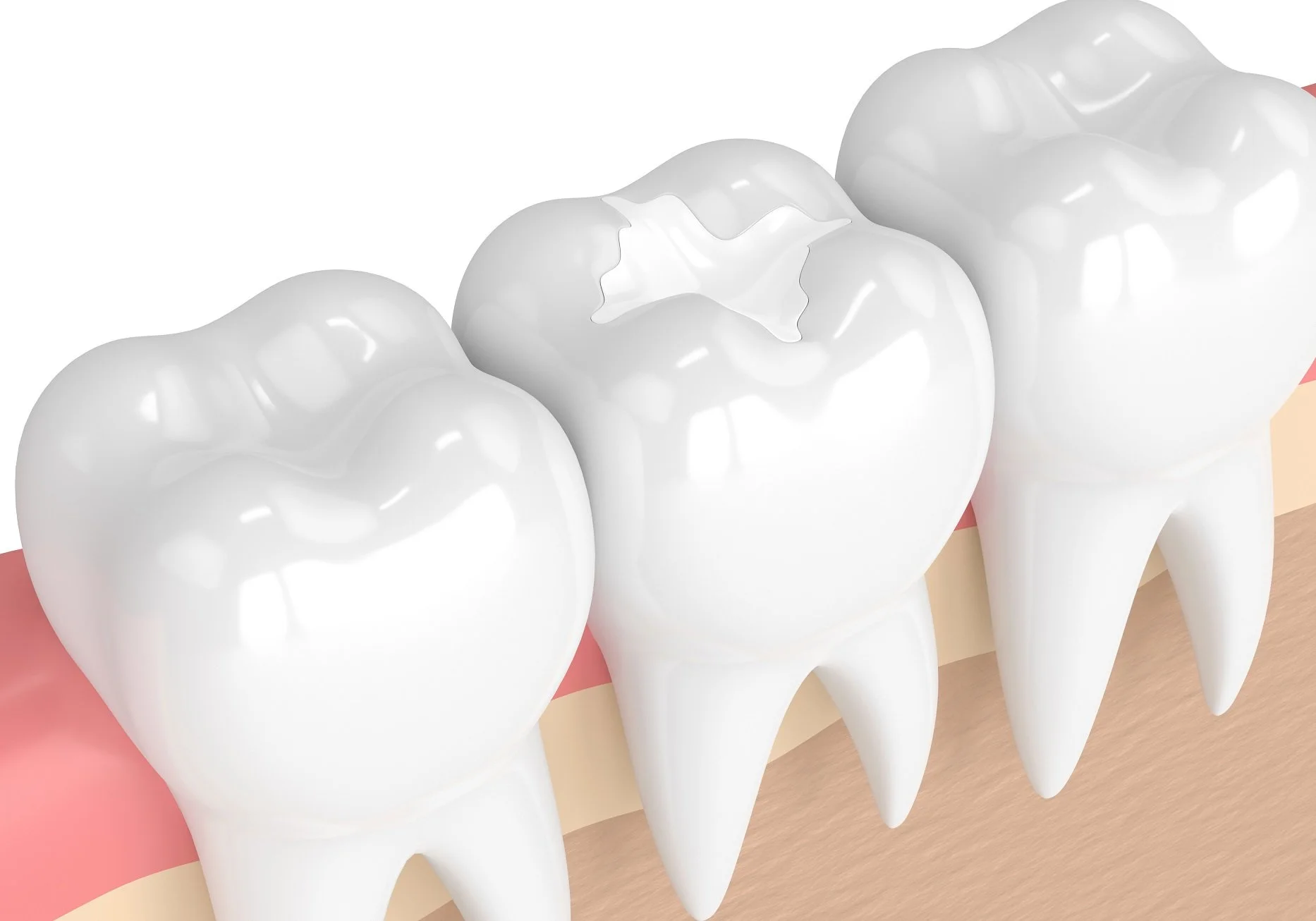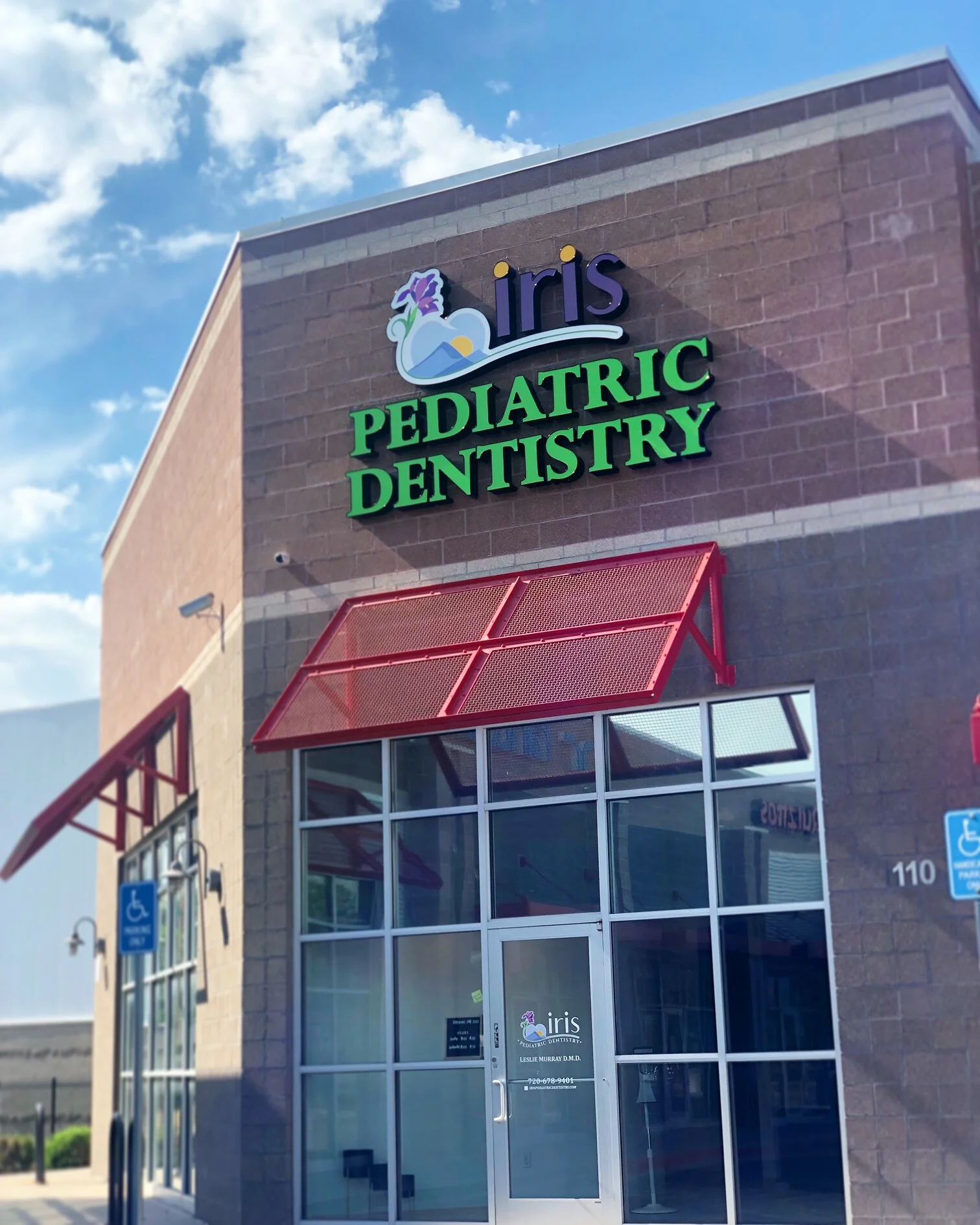Learn about our services
-
Why does my child need a visit, they only have a few teeth?
I get it, you’re busy, but did you know that even brand-new baby teeth can get cavities? And that many baby teeth don’t fall out until after age 11??
When infants have only a few teeth, this is a perfect time for new parents to learn how to care for their child and their new chompers. The American Academy of Pediatric Dentistry recommends all children see a pediatric dentist within 6 months of getting their first tooth or by age one.
What do we do at this visit?
A whole bunch of parent education, followed by an easy infant-appropriate exam, brushing and fluoride treatment. Easy visits can teach you how to thrive as a parent, prevent cavities, have easier brushing at home, develop good food and beverage habits and gives you an opportunity to ask any other questions you may have (do I really need to floss my 18 month old?).
Treatment early childhood cavities can be less invasive if caught early, and kids tend to do better for visits later if they are familiar with the dentist as a toddler. Your child will do better than you think!
-
These visits really focus on developing good habits and catching cavities as early as possible. We talk to the child and the parent about the whole world of brushing, foods that prevent and can cause cavities, losing wiggly teeth and developing grown up teeth. If children have cavities, we have many options to make it easy, from minimally invasive options. fillings with our needle free CO2 Solea Laser, laughing gas, movies, and popsicles, to hospital based general anesthesia.
-
This is our last chance to really foster good habits before our patients graduate to an adult dentist! We focus on treating them like the drivers of their health, educating and encouraging them to develop skills for success. Treatment is often easy for these patients, but if anyone has had a history of difficult visits, we are happy to offer many options to make it easier. We have options from fillings with our needle free CO2 Solea Laser, to laughing gas and movies, to hospital based general anesthesia.
-
Dr. Leslie and Dr. Kate both completed additional specialty training to be able to safely care for your children with a wide range of special needs. Please let us know when scheduling so we can ensure that we are prepared to support your child in whatever way they need (quieter office hours, in a movie room for distraction, increased infection precautions if immunocompromised, or to consult with other medical providers if necessary). It is our pleasure to work with all children in our practice
CLEANINGS FOR CHILDREN OF ALL AGES
SPECIALIZED CARE FOR CHILDREN WITH SPECIAL HEALTHCARE NEEDS
-
Why does my child need a visit, they only have a few teeth?
I get it, you’re busy, but did you know that even brand-new baby teeth can get cavities? And that many baby teeth don’t fall out until after age 11??
When infants have only a few teeth, this is a perfect time for new parents to learn how to care for their child and their new chompers. The American Academy of Pediatric Dentistry recommends all children see a pediatric dentist within 6 months of getting their first tooth or by age one.
What do we do at this visit?
A whole bunch of parent education, followed by an easy infant-appropriate exam, brushing and fluoride treatment. Easy visits can teach you how to thrive as a parent, prevent cavities, have easier brushing at home, develop good food and beverage habits and gives you an opportunity to ask any other questions you may have (do I really need to floss my 18 month old?).
Treatment early childhood cavities can be less invasive if caught early, and kids tend to do better for visits later if they are familiar with the dentist as a toddler. Your child will do better than you think!
WHITE FILLINGS
-
o What is in a white filling?
Depending on the size of the cavity and your child’s age our doctors choose from a few white filling materials to provide the best care. Either Voco Admira Fusion, Fuji Glass Ionomer or Equia Forte Glass Ionomer.
None of these materials contain mercury, BPA or Bis-GMA and were specifically selected for their safety and excellent clinical results.
o Have specific questions about cavities or dental material options? Dr. Leslie or Dr. Kate would be happy to speak with you during your child’s visit.
WHITE AND SILVER CROWNS
-
o Baby teeth are more fragile than grown up teeth, and can require a dental crown if they have a medium to large cavities. Our office provides white zirconia or composite crowns for front teeth depending on your child’s teeth. For back teeth we provide silver colored stainless-steel crowns- no mercury! This material is excellent for baby molars because it is thin, but still very strong. This allow years of chewing, playing and cheering before they fall out in pre-teen years.
o Have specific questions about crowns and treatment options for your child? Dr. Leslie or Dr. Kate would be happy to speak with you during your child’s visit.
PULP TREATMENTS AND BABY ROOT CANALS
-
o Cavities can grow VERY fast in children. When the bacteria from a cavity reach the nerve (pulp) of the tooth, it can require medication to allow us to save the tooth without turning into an infection. This procedure can be completed painlessly and quickly in the office for children who are cooperative or during general anesthesia for those that are very nervous, young, or have other special needs. Have questions about this process or if it is indicated for your child?
Dr. Leslie or Dr. Kate would be happy to speak with you during your child’s visit.
DENTAL EXTRACTIONS
-
o Sometimes a tooth requires removal if they are infected, causing pain or for orthodontic reasons.
SILVER DIAMINE FLUORIDE AND MINIMALLY INVASIVE OPTIONS
-
o Silver Diamine Fluoride (SDF) is a topical liquid medicine that slow down or even stop small to medium size cavities from growing. This medicine is often used for very young children or those with special needs while we are working on coordinating other treatment. Many times these teeth will still need a filling or crown later, but it can delay treatment by months or even years with good home brushing and healthy diet. It also can sometimes be used to slow down a cavity in a tooth that is going to fall out in the next year or so.
SDF does cause a permanent color changing the cavity from a yellow/brown color to black. This color can be removed later by our Doctors and replaced with a white filling or dental crown.
NEEDLE-FREE FILLINGS WITH OUR CO2 SOLEA LASER
-
o This technology is state of the art! Our Solea uses a green laser beam along with air and water to remove small to medium cavities without the sensitivity of a dental drill and without anesthetic or a shot. Many children report that this procedure feels cold, but not uncomfortable, and are able to easily complete fillings. We offer this treatment to all children when the tooth has the appropriate type and size of cavity, and as long as they are comfortable, then no numbing needed! After using the Solea Laser, the filling is placed the same as traditional dental fillings.
LAUGHING GAS WITH A MOVIE FOR TREATMENT
-
o We have a license for showing Disney Plus in our treatment rooms. Let your child choose their comfort show or movie to help pass the time.
Laughing gas has a light fruity scented nose and will relax most children. This does not put them to “sleep” but does relax them. They will remember the treatment and be back to normal after breathing 5 minutes of oxygen when treatment is completed.
EMERGENCY TREATMENT FOR PAIN OR TRAUMA
-
Why does my child need a visit, they only have a few teeth?
I get it, you’re busy, but did you know that even brand-new baby teeth can get cavities? And that many baby teeth don’t fall out until after age 11??
When infants have only a few teeth, this is a perfect time for new parents to learn how to care for their child and their new chompers. The American Academy of Pediatric Dentistry recommends all children see a pediatric dentist within 6 months of getting their first tooth or by age one.
What do we do at this visit?
A whole bunch of parent education, followed by an easy infant-appropriate exam, brushing and fluoride treatment. Easy visits can teach you how to thrive as a parent, prevent cavities, have easier brushing at home, develop good food and beverage habits and gives you an opportunity to ask any other questions you may have (do I really need to floss my 18 month old?).
Treatment early childhood cavities can be less invasive if caught early, and kids tend to do better for visits later if they are familiar with the dentist as a toddler. Your child will do better than you think!
SPACE MAINTAINERS AND ORTHODONTIC REFERRALS
-
Why does my child need a visit, they only have a few teeth?
I get it, you’re busy, but did you know that even brand-new baby teeth can get cavities? And that many baby teeth don’t fall out until after age 11??
When infants have only a few teeth, this is a perfect time for new parents to learn how to care for their child and their new chompers. The American Academy of Pediatric Dentistry recommends all children see a pediatric dentist within 6 months of getting their first tooth or by age one.
What do we do at this visit?
A whole bunch of parent education, followed by an easy infant-appropriate exam, brushing and fluoride treatment. Easy visits can teach you how to thrive as a parent, prevent cavities, have easier brushing at home, develop good food and beverage habits and gives you an opportunity to ask any other questions you may have (do I really need to floss my 18 month old?).
Treatment early childhood cavities can be less invasive if caught early, and kids tend to do better for visits later if they are familiar with the dentist as a toddler. Your child will do better than you think!
TONGUE-TIE AND FRENECTOMY EVALUATION AND TREATMENT WITH OUR CO2 COLD SOLEA LASER
-
Why does my child need a visit, they only have a few teeth?
I get it, you’re busy, but did you know that even brand-new baby teeth can get cavities? And that many baby teeth don’t fall out until after age 11??
When infants have only a few teeth, this is a perfect time for new parents to learn how to care for their child and their new chompers. The American Academy of Pediatric Dentistry recommends all children see a pediatric dentist within 6 months of getting their first tooth or by age one.
What do we do at this visit?
A whole bunch of parent education, followed by an easy infant-appropriate exam, brushing and fluoride treatment. Easy visits can teach you how to thrive as a parent, prevent cavities, have easier brushing at home, develop good food and beverage habits and gives you an opportunity to ask any other questions you may have (do I really need to floss my 18 month old?).
Treatment early childhood cavities can be less invasive if caught early, and kids tend to do better for visits later if they are familiar with the dentist as a toddler. Your child will do better than you think!
IN-OFFICE GENERAL ANESTHESIA
-
Why does my child need a visit, they only have a few teeth?
I get it, you’re busy, but did you know that even brand-new baby teeth can get cavities? And that many baby teeth don’t fall out until after age 11??
When infants have only a few teeth, this is a perfect time for new parents to learn how to care for their child and their new chompers. The American Academy of Pediatric Dentistry recommends all children see a pediatric dentist within 6 months of getting their first tooth or by age one.
What do we do at this visit?
A whole bunch of parent education, followed by an easy infant-appropriate exam, brushing and fluoride treatment. Easy visits can teach you how to thrive as a parent, prevent cavities, have easier brushing at home, develop good food and beverage habits and gives you an opportunity to ask any other questions you may have (do I really need to floss my 18 month old?).
Treatment early childhood cavities can be less invasive if caught early, and kids tend to do better for visits later if they are familiar with the dentist as a toddler. Your child will do better than you think!
GENERAL ANESTHESIA AT CHILDREN’S HOSPITAL OF COLORADO WITH DR.LESLIE & DR.KATE
-
Why does my child need a visit, they only have a few teeth?
I get it, you’re busy, but did you know that even brand-new baby teeth can get cavities? And that many baby teeth don’t fall out until after age 11??
When infants have only a few teeth, this is a perfect time for new parents to learn how to care for their child and their new chompers. The American Academy of Pediatric Dentistry recommends all children see a pediatric dentist within 6 months of getting their first tooth or by age one.
What do we do at this visit?
A whole bunch of parent education, followed by an easy infant-appropriate exam, brushing and fluoride treatment. Easy visits can teach you how to thrive as a parent, prevent cavities, have easier brushing at home, develop good food and beverage habits and gives you an opportunity to ask any other questions you may have (do I really need to floss my 18 month old?).
Treatment early childhood cavities can be less invasive if caught early, and kids tend to do better for visits later if they are familiar with the dentist as a toddler. Your child will do better than you think!















